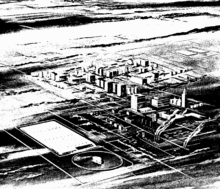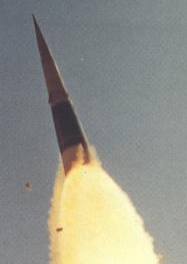Nike-X
To provide the needed speed and accuracy, as well as deal with multi-warhead attacks, Nike-X used a new radar system and building-filling computers that could track hundreds of objects at once and control salvos of many Sprints.
[21] A study by the Weapons Systems Evaluation Group (WSEG) calculated that the Soviets had a 90 percent chance of successfully hitting a Zeus base by firing only four warheads at it.
Decoys are made of lightweight materials, often strips of aluminum or mylar balloons, which can be packed in with the reentry vehicle (RV), adding little weight.
[27] The resulting Project Defender was extremely broad in scope, considering everything from minor Zeus system upgrades to far-out concepts like antigravity and the recently invented laser.
[30] The name Nike-X was apparently an ad hoc suggestion by Jack Ruina, the director of ARPA, who was tasked with presenting the options to the President's Science Advisory Committee (PSAC).
[31] With the ending of Zeus, the ZMAR radar effort was renamed MAR, and plans for an even more powerful version, MAR-II, became the central part of the Nike-X concept.
[38][39] Nike-X intended to wait until the decluttering was complete, meaning the interceptions would take place only seconds before the warheads hit their targets, between 5 and 30 miles (8.0–48.3 km) away from the base.
[42] It also meant that the threat tube trajectories would have to be calculated rapidly, before or between blackout periods, and the final tracking of the warheads in the 10 seconds or so between clearing the clutter and hitting their targets.
While one beam scanned the sky for new targets, others were formed to examine the threat tubes and generate high-quality tracking information very early in the engagement.
To make all of this work, MAR required data processing capabilities on an unprecedented level, so Bell proposed building the system using the newly invented resistor–transistor logic small-scale integrated circuits.
MSR would have just enough power and logic to generate tracks for its outgoing Sprint missiles and would hand that information off to the DCDPS using conventional telephone lines and modems.
[60] Things changed in the early 1960s when McNamara placed limits on the Air Force fleet of 1,000 Minuteman missiles and 54 Titan IIs.
As Morton Halperin noted: In part this was a reflex reaction, a desire not to have Air Force missiles protected by "Army" ABMs. ...
[67] Originally intended to protect only the largest urban areas, Nike-X was designed to be built at a very large size with many missiles controlled by an expensive computer and radar network.
[71] This led to proposals for a new radar dedicated solely to the early warning role, determining only which MAR or SCD would ultimately have to deal with the threat.
[72] The high-altitude explosions that had caused so much concern for Nike Zeus due to blackout had been further studied in the early 1960s and led to a new possibility for missile defense.
[74] A January 1965 report[f] outlines this possibility, noting that it would have to have a much larger warhead dedicated to the production of X-rays, and would have to operate at higher altitudes to maximize the effect.
[85] None of these concepts appeared to be worth deploying, but there was considerable pressure from Congressional groups dominated by hawks who continued to force development of the ABM even when McNamara and President Johnson had not asked for it.
[86] McNamara attempted to short-circuit deployment in early 1966 by stating that the only program that had any reasonable cost-effectiveness was the thin defense against the Chinese, and then noted there was no rush to build such a system as it would be some time before they had an ICBM.
[85] Another meeting on the issue was called on 6 December 1966, attended by Johnson, McNamara, the deputy Secretary of Defense Cyrus Vance, Walt Rostow of the National Security Agency (NSA) and the Joint Chiefs.
However, McNamara once again outlined the problems and stated that the simplest way to close the ABM gap was to simply build more ICBMs, rendering the Soviet system impotent and a great waste of money.
Initial contracts were offered to Sylvania and General Electric (GE), who both built experimental systems consisting of a single row of elements, essentially a slice of a larger array.
A full sized, four-sided MAR would require 25,620 parametric amplifiers to be individually wired by hand, so building the smaller MAR-I greatly reduced cost and construction time.
[92] However, the system demonstrated very low reliability in the transmitter's travelling wave tube (TWT) amplifiers, which led to an extremely expensive re-design and re-installation.
In November, the building was re-purposed as the main fallout shelter for everyone at Holloman Air Force Base, about 25 miles (40 km) to the east.
[106] Bell ran studies to identify the sweet spot for the MSR that would allow it to have enough functionality to be useful at different stages of the attack, as well as being inexpensive enough to justify its existence in a system dominated by MAR.
[107] Of the seven proposals received, Raytheon won the development contract in December 1963, with Varian providing the high-power klystrons (twystrons) for the transmitter.
The MSR was built in a boxy extension on the northwestern corner of the roof, with two sides angled back to form a half-pyramid shape where the antennas were mounted.
During the threat verification phase, the radar spent more time examining the returns in an effort to accurately determine the trajectory and then ignored any objects that would fall outside its area.
[137] Although a primary concern of the Sprint missile was high speed, the design was not optimized for maximum energy, but instead relied on the first stage (booster) to provide as much thrust as possible.
















